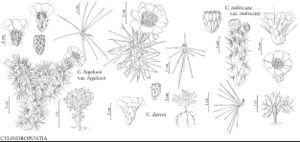Difference between revisions of "Cylindropuntia bigelovii var. bigelovii"
FNA>Volume Importer |
imported>Volume Importer |
||
| (6 intermediate revisions by 2 users not shown) | |||
| Line 1: | Line 1: | ||
{{Treatment/ID | {{Treatment/ID | ||
|accepted_name=Cylindropuntia bigelovii var. bigelovii | |accepted_name=Cylindropuntia bigelovii var. bigelovii | ||
| − | |accepted_authority= | + | |accepted_authority= |
|publications= | |publications= | ||
|basionyms= | |basionyms= | ||
| Line 19: | Line 19: | ||
|elevation=300-900 m | |elevation=300-900 m | ||
|distribution=Ariz.;Calif.;Nev.;Mexico (Baja California Sur;Sonora). | |distribution=Ariz.;Calif.;Nev.;Mexico (Baja California Sur;Sonora). | ||
| − | |discussion=<p>Cylindropuntia bigelovii forms two hybrids. Cylindropuntia ×fosbergii (C. B. Wolf) Rebman, M. A. Baker & Pinkava (= C. bigelovii × C. echinocarpa), which L. D. Benson (1982) treated as Opuntia bigelovii var. hoffmannii Fosberg, occurs southwest of the Salton Sea, California, forms shrubby trees 1–2 m with yellow-green inner tepals and green filaments, and has a chromosome number of 2n = 33. Cylindropuntia ×campii (M. A. Baker & Pinkava) M. A. Baker & Pinkava (= C. bigelovii × C. acanthocarpa) forms more open trees than O. bigelovii, has yellow-green inner tepals and filaments, and has a chromosome number of 2n = 44.</p> | + | |discussion=<p><i>Cylindropuntia bigelovii</i> forms two hybrids. <i>Cylindropuntia</i> ×fosbergii (C. B. Wolf) Rebman, M. A. Baker & Pinkava (= <i>C. bigelovii</i> × <i>C. echinocarpa</i>), which L. D. Benson (1982) treated as <i>Opuntia</i> bigelovii <i></i>var.<i> hoffmannii</i> Fosberg, occurs southwest of the Salton Sea, California, forms shrubby trees 1–2 m with yellow-green inner tepals and green filaments, and has a chromosome number of 2n = 33. <i>Cylindropuntia</i> ×campii (M. A. Baker & Pinkava) M. A. Baker & Pinkava (= <i>C. bigelovii</i> × <i>C. acanthocarpa</i>) forms more open trees than O. bigelovii, has yellow-green inner tepals and filaments, and has a chromosome number of 2n = 44.</p> |
|tables= | |tables= | ||
|references= | |references= | ||
| Line 28: | Line 28: | ||
-->{{#Taxon: | -->{{#Taxon: | ||
name=Cylindropuntia bigelovii var. bigelovii | name=Cylindropuntia bigelovii var. bigelovii | ||
| − | + | |authority= | |
| − | |authority= | ||
|rank=variety | |rank=variety | ||
|parent rank=species | |parent rank=species | ||
| Line 43: | Line 42: | ||
|publication year= | |publication year= | ||
|special status= | |special status= | ||
| − | |source xml=https:// | + | |source xml=https://bitbucket.org/aafc-mbb/fna-data-curation/src/2e0870ddd59836b60bcf96646a41e87ea5a5943a/coarse_grained_fna_xml/V4/V4_207.xml |
|subfamily=Cactaceae subfam. Opuntioideae | |subfamily=Cactaceae subfam. Opuntioideae | ||
|genus=Cylindropuntia | |genus=Cylindropuntia | ||
Latest revision as of 22:57, 5 November 2020
Trees, densely branched, with older branches at base of crown dark brown, clinging to usually solitary trunk, 0.3–1.5(–3) m. Stem segments whorled or subwhorled, green to gray-green, 4–13(–18) × (2–)4–5.5 cm, distal ones usually very easily detached (propagules); tubercles salient, broadly oval, 0.4–0.8 cm; areoles elliptic-deltate, 5–6 ×3–4 mm; wool white-yellow to brownish, aging gray. Spines (8–)10–15 per areole, at most areoles, interlaced with spines of adjacent areoles, usually uniformly, diffusely spreading and nearly completely obscuring stem, pale yellow to yellow to tan, aging brown; abaxial spines spreading to deflexed, subterete to flattened, the longest (10–)15–25 mm; adaxial spines erect or spreading, terete, the longest (10–)20–28 mm; sheaths uniformly whitish or pale yellow, not obviously baggy. Glochids in broad adaxial crescent, sometimes extending along areole margins, yellow, 3–4 mm. Flowers: inner tepals pale green to whitish, sometimes tipped red, spatulate, (15–)20–25 mm, emarginate-apiculate, often erose; filaments green; anthers orange; style light green; stigma lobes light to dark green. Fruits usually sterile, not proliferating, yellow at maturity, cylindric to broadly obconic, (15–)22–40 × (8–)16–20(–28) mm, fleshy-leathery, strongly tuberculate, becoming spineless, losing bristlelike spines of young fruit; umbilicus 8–10 mm deep; areoles 36–64, evenly spaced. Seeds, when present, pale yellow, in gelatinous mass, angular to squarish in outline, 2.5–4 × 2.2–3.5 mm, warped, sides with 1–2 large depressions; girdle smooth or as very narrow marginal ridge. 2n = 22 or, usually, 33.
Phenology: Flowering spring–fall (Mar–Jun, Sep).
Habitat: Mojave and Sonoran deserts, sandy flats, gravelly to rocky washes, bajadas, hillsides
Elevation: 300-900 m
Distribution

Ariz., Calif., Nev., Mexico (Baja California Sur, Sonora).
Discussion
Cylindropuntia bigelovii forms two hybrids. Cylindropuntia ×fosbergii (C. B. Wolf) Rebman, M. A. Baker & Pinkava (= C. bigelovii × C. echinocarpa), which L. D. Benson (1982) treated as Opuntia bigelovii var. hoffmannii Fosberg, occurs southwest of the Salton Sea, California, forms shrubby trees 1–2 m with yellow-green inner tepals and green filaments, and has a chromosome number of 2n = 33. Cylindropuntia ×campii (M. A. Baker & Pinkava) M. A. Baker & Pinkava (= C. bigelovii × C. acanthocarpa) forms more open trees than O. bigelovii, has yellow-green inner tepals and filaments, and has a chromosome number of 2n = 44.
Selected References
None.
